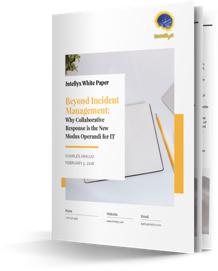Real-Time Collaborative Response

As IT organizations step headlong into the digital era, they are finding that the rules have changed. The traditional roles and processes that they have used to guide their operations are no longer sufficient when speed and agility are the chief drivers of not
only advantage, but of survival. That’s where Collaborative Response comes in.

Collaborative Response
Enterprises have responded to the demands of this new era with a broad diversity of applications and by increasing the rate at which they deploy, change, and sunset them. They have adopted approaches such as Agile and DevOps to meet the corresponding
need for increased velocity, but have not adapted their support approaches commensurately.
In this fast-moving environment, the linear support practices of the past simply cannot keep up and are insufficient to help organizations cut through the organizational and architectural complexity of the modern enterprise organization.
The IT industry has codified those support practices in ITIL, the industry’s predominant IT Service Management (ITSM) framework, as Incident Management. And because this is the way it has always worked, there has been no reason for IT organizations to change it.
Until now….
Assembling you Collaborative Response toolset
Adopting a Collaborative Response approach requires two things: a cultural shift and an integrated toolset that enables it.
The cultural shift requires that teams stop looking at support as a linear process and instead view it as a highly integrated, collaborative, and iterative process in which teams self-assess, self-organize, and self-manage issues as they arise.
While the cultural shift will take management support and changes in process, it will not succeed without an integrated toolset that can support this type of fast-paced interaction. While there are several approaches organizations can take to create such a toolset, there are several essential characteristics that it should possess:
The essence of Collaborative Response is self-organization and management, but this can only occur if teams can communicate and collaborate in real time. While IT systems of record remain essential, the integrated toolset supporting Collaborative Response must enable team members to intelligently manage, escalate, and collaborate on incidents in real time.
How xMatters supports this
xMatters provides a complete integration platform with APIs and a fully-functional development environment. This enables teams to work with the tools they trust and prefer (more on this later), but also enables them to move data freely and rapidly to the normal point of engagement (e.g. from an alert into a service desk ticket and then into chat channels and collaboration tools) – all while saving the transaction information in the originating system. This enables teams to combine alerts from multiple systems, enrich them with data, historical context, and analytics, and use all of it in real time to respond more intelligently.

